
The Battle of Montmirail was fought between a French force led by Emperor Napoleon and two Allied corps commanded by Fabian Wilhelm von Osten-Sacken and Ludwig Yorck von Wartenburg. In hard fighting that lasted until evening, French troops including the Imperial Guard defeated Sacken's Russian soldiers and compelled them to retreat to the north. Part of Yorck's Prussian I Corps tried to intervene in the struggle but it was also driven off. The battle occurred near Montmirail, France, during the Six Days Campaign of the Napoleonic Wars. Montmirail is located 51 kilometres (32 mi) east of Meaux.

The Battle of Wavre was the final major military action of the Hundred Days campaign and the Napoleonic Wars. It was fought on 18–19 June 1815 between the Prussian rearguard, consisting of the Prussian III Corps under the command of General Johann von Thielmann and three corps of the French army under the command of Marshal Grouchy. A blocking action, this battle kept 33,000 French soldiers from reaching the Battle of Waterloo and so helped in the defeat of Napoleon at Waterloo.

The Battle of Château-Thierry saw the Imperial French army commanded by Emperor Napoleon attempt to destroy a Prussian corps led by Ludwig Yorck von Wartenburg and an Imperial Russian corps under Fabian Wilhelm von Osten-Sacken. The two Allied corps managed to escape across the Marne River, but suffered considerably heavier losses than the pursuing French. This action occurred during the Six Days' Campaign, a series of victories that Napoleon won over Prussian Field Marshal Gebhard Leberecht von Blücher's Army of Silesia. Château-Thierry lies about 75 kilometres (47 mi) northeast of Paris.
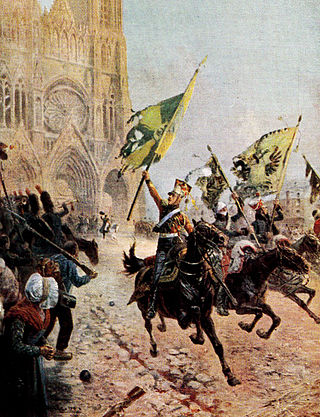
The Battle of Reims was fought at Reims, France between an Imperial French army commanded by Emperor Napoleon and a combined Russian-Prussian corps led by General Emmanuel de Saint-Priest. On the first day, Saint-Priest's Russians and General Friedrich Wilhelm von Jagow's Prussians easily captured Reims from its French National Guard garrison, capturing or killing more than half of its defenders. On the second day, an overconfident Saint-Priest carelessly deployed his forces west of the city, not grasping that Napoleon was approaching with 20,000 troops. Too late, Saint-Priest realized who he was fighting and tried to organize a retreat. In the battle that followed, the French army struck with crushing force and the Allies were routed with serious losses. During the fighting, Saint-Priest was struck by a howitzer shell and died two weeks later.

The Battle of Charleroi or the Battle of the Sambre, was fought on 21 August 1914, by the French Fifth Army and the German 2nd and 3rd armies, during the Battle of the Frontiers. The French were planning an attack across the Sambre River, when the Germans attacked first, forced back the French from the river and nearly cut off the French retreat by crossing the Meuse River around Dinant and getting behind the French right flank. The French were saved by a counter-attack at Dinant and the re-direction of the 3rd Army to the north-west in support of the 2nd Army, rather than south-west.

This is the order of battle for both the Russian and German armies at the Battle of Tannenberg, August 17 to September 2, 1914.
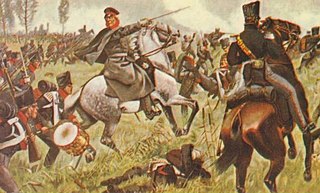
The Battle of Wartenburg took place on 3 October 1813 between the French IV Corps commanded by General Henri Gatien Bertrand and the Allied Army of Silesia, principally the I Corps of General Ludwig von Yorck. The battle allowed the Army of Silesia to cross the Elbe, ultimately leading to the Battle of Leipzig.
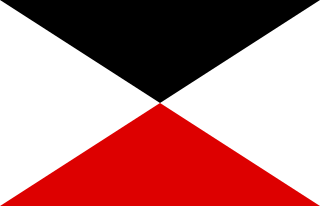
The IV Army Corps / IV AK was a corps level command of the Prussian and then the Imperial German Armies from the 19th Century to World War I.
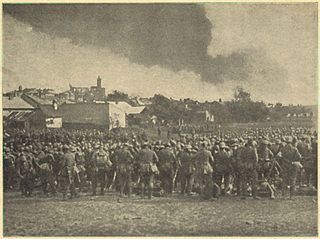
The 1st Landwehr Division was an infantry division of the Imperial German Army during World War I. It was formed on the mobilization of the German Army in August 1914 under the "Higher Landwehr Commander 1" and, initially, also referred to as the "Landwehr-Division Goltz" after its commander. The Landwehr was the third category of the German Army, after the regular Army and the reserves. Thus Landwehr divisions were made up of older soldiers who had passed from the reserves, and were intended primarily for occupation and security duties rather than heavy combat.
This is an order of battle of the French and German Armies at the beginning of the Franco-Prussian War in 1870.
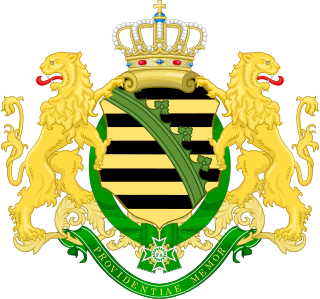
The Royal Saxon Army was the military force of the Electorate (1682–1807) and later the Kingdom of Saxony (1807–1918). A regular Saxon army was first established in 1682 and it continued to exist until the abolition of the German monarchies in 1918. With the formation of the Confederation of the Rhine by Napoleon the Royal Saxon Army joined the French "Grande Armée" along with 37 other German states.
This is the German Army order of battle on the outbreak of World War I in August 1914.
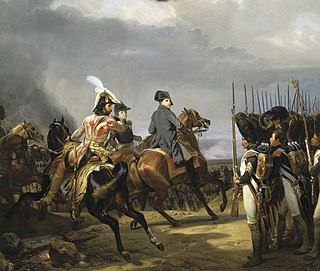
The Jena-Auerstedt campaign order of battle is listed below. The order of battle includes units from the First French Empire and the Kingdom of Prussia that fought each other in the campaign that included the decisive Battle of Jena-Auerstedt on 14 October 1806. The order of battle may be useful to trace the battles of Schleiz and Saalfeld, which occurred before Jena-Auerstedt, as well as battles and capitulations that happened after 14 October, such as Erfurt, Halle, Prenzlau, Pasewalk, Stettin, Waren-Nossentin, and Lübeck.

Jean-Baptiste Solignac fought in the French Army during the French Revolutionary Wars and the Napoleonic Wars, attaining the rank of general of division. Solignac served as the chief of staff of André Massena in Italy, and helped Massena enrich himself by looting. He fought at Magnano and was wounded at Novi in 1799. He led a brigade at Caldiero in 1805. Solignac was dismissed in 1806 for embezzling, but was reactivated to lead a brigade in the 1807 Invasion of Portugal. He was badly wounded at Vimeiro. He led a division during Massena's invasion of Portugal and fought at Fuentes de Oñoro. Dismissed again in 1811, he was again restored to command and fought at Courtrai in 1814. He was dismissed from the army in 1815 and not restored to command until 1830. He finally retired from the army in 1834 and died in 1850. SOLIGNAC is among the names inscribed under the Arc de Triomphe.
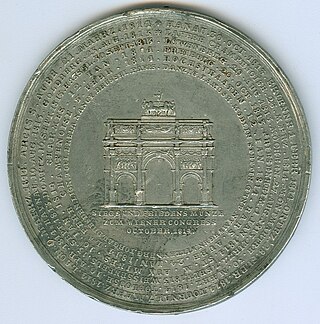
The Battle of Hoogstraten was fought on 11 January 1814 between a French army, led by François Roguet, and a Russo-Prussian-British army, led by Friedrich Wilhelm Freiherr von Bülow. The battle, which ended in a Prussian victory, consisted of a series of engagements situated between Essen and Turnhout. The battle was named after Hoogstraten, the main town of the Kempen region.

The First Battle of Bar-sur-Aube was fought during the War of the Sixth Coalition when Marshal Édouard Mortier, duc de Trévise's corps of French Imperial Guards defended against an Austrians corps under Ignaz Gyulai and a Württemberger corps led by Crown Prince Frederick William of Württemberg. After holding his main defensive positions in stiff fighting, Mortier withdrew his elite troops during the night and retreated to Troyes. Bar-sur-Aube is located 53 kilometres (33 mi) east of Troyes.

The Battle of Arnhem saw Friedrich Wilhelm Freiherr von Bülow's Prussian corps fight an Imperial French division under Henri François Marie Charpentier at Arnhem. Attacking under the cover of fog, the Prussians broke into the city at several points and forced the French to retreat to Nijmegen after hard fighting in this War of the Sixth Coalition clash. Arnhem is a city in the Netherlands located on the Rhine River 100 kilometres (62 mi) southeast of Amsterdam.

Claude Marie Meunier became a French division commander during the Napoleonic Wars. He joined a volunteer regiment in 1792 and fought on the Rhine and in Italy as a captain. After a stint in the Consular Guard as a major, he became colonel of the 9th Light Infantry Regiment in 1803. His regiment fought at Haslach and Dürenstein in 1805, Halle, Waren and Lübeck in 1806, and Mohrungen and Friedland in 1807. Transferred to Spain, he led his troops at Uclés, Medellín and Talavera in 1809. He was promoted general of brigade in 1810 and fought at Barrosa in 1811.

General of Division Baron Pierre Decouz became a French division commander during the later Napoleonic Wars. He was born in the Kingdom of Sardinia but after the region was annexed to France, he joined a volunteer battalion in 1793. He fought in Italy during the War of the First Coalition. He participated in the French campaign in Egypt and Syria, fighting at the Pyramids, Acre and Abukir. After distinguishing himself at Austerlitz in 1805, he was promoted to command an infantry regiment. In 1806–1807 he led his regiment at Auerstädt, Pultusk and Eylau. In 1809 he fought at Eckmühl, Ratisbon and Wagram, winning promotion to general of brigade. After leading an Imperial Guard brigade at Lützen and Bautzen in 1813, he was promoted general of division. He commanded a Young Guard division at Dresden and Leipzig. Still leading a Young Guard division, he was fatally wounded at the Battle of Brienne and died three weeks later. His surname is one of the names inscribed under the Arc de Triomphe, on Column 17.

Pierre Barrois became a French division commander during the Napoleonic Wars. He joined a volunteer battalion in 1793 that later became part of a famous light infantry regiment. He fought at Wattignies, Fleurus, Aldenhoven, Ehrenbreitstein and Neuwied in 1793–1797. He fought at Marengo in 1800. He became colonel of a line infantry regiment in 1803 and led it at Haslach, Dürrenstein, Halle, Lübeck and Mohrungen in 1805–1807. Promoted to general of brigade, he led a brigade at Friedland in 1807.
























